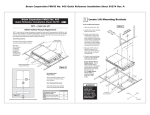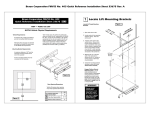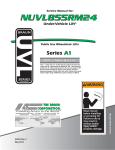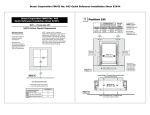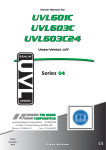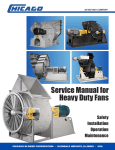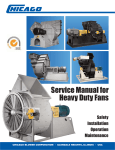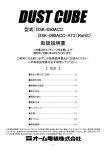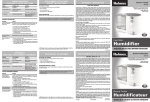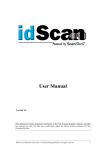Download Braun Personal Lift Corporation FMVSS No. 403 User's Manual
Transcript
Braun Corporation FMVSS No. 403 Quick Reference Installation Sheet 32553 Rev. A 1 Locate Lift Mounting Brackets NHTSA Vehicle Physical Requirements Mounting Bracket Requirements: A maximum distance of 16" from the outermost mounting bracket to the end of the cassette. All four mounting brackets must be connected to the framerails. CH All-thread Mounting Brackets Figure A 16 Ma ” xim u m A 855 A Figure B OSS E N IN G P 90 O " 3/8 22" 3/8 22- All-Thread Mounting Brackets Engage Platform Manual Release System: The lift cable-activated platform manual release is disengaged during shipment to prevent potential drive chain stretch. Handle the lift with care. Engage manual release before attempting to install (raise, tilt or move) the lift. Door Opening Dimensions Vehicle lift access door opening must meet specified dimensions. C ME 5. Clamp the mounting brackets securely in place (all-thread studs must be vertical). LE R HIC BE VE MEM SIS AS CH B FRA 3. Transfer center point to the vehicle frame. Using a frontto-rear framing member as a guide, transfer the center point across chassis to opposite side front-to-rear framing member (must be 90° to door opening). Lift mounting bracket positions are based on this center line. 4. Measure 22-3/8" to left and right of the center line to achieve the 44-3/4" center-tocenter spacing of all-thread mounting studs. LE R HIC BE VE MEM SIS AS E ACR O Alternative floor structures are allowed providing the installed lift system passes all FMVSS 403 requirements. 2. Locate center of door opening (between doors). Mark the center point. TER ICL D All vehicles with a GVW over 6000 lbs. and with unmodified OEM framerails. “DOT - Public Use Lift” verifies this platform lift meets the “public use lift” requirements of FMVSS No. 403. This lift may be installed on all vehicles appropriate for the size and weight of the lift, but must be installed on buses, school buses, and multi-purpose passenger vehicles other than motor homes with a gross vehicle weight rating (GVWR) that exceeds 4,536 kg (10,000 lb). N RI TE NING N CE OPE OR O D CL CEN VEH 1. Open both doors to 90°. Vehicle Requirements: Figure C Locate All-Thread Mounting Brackets “DOT — Public Use Lift” B C Minimum Clear Door Opening Height Clear Door Opening Width Maximum Floor-to-Ground NA 43-1/2" 50" WARNING Engage manual release before attempting to install (raise, tilt or move) lift. Failure to do so may result in serious bodily injury and/or property damage. O Rev: A R Braun Corporation FMVSS No. 403 Quick Reference Installation Sheet 32253 WARN ING Push manuall T-handle and y lock out movein fully to before Failure platform engage and result to driving platform in deploym in lock vehicle. platform platform unintend result ent. ed may Unintend platform and/orin deploym serious property ent ed may bodily damageinjury Do not . remov e! 81823 " 3/4 44- Braun Corporation FMVSS No. 403 Quick Reference Installation Sheet 32553 Rev. A 2 Secure Lift Figure G LE R HIC BE VE MEM SIS S A CH “Channel” Framing Member Attach Mounting Brackets to Vehicle Frame Mounting bolts must be routed horizontally through the vertical face of the “L” brackets and framing members as shown in Figures D, E and F. Eight 3/8-16 x 1-1/2" hex bolts are supplied for bolting the allthread mounting brackets to the frame (two per bracket). Oval slotted mounting holes are provided in the mounting brackets to allow adjustment. Carefully drill 25/64" (.390") diameter mounting holes at the center of the oval mounting slots. Hex Nut Figure D LE R HIC BE VE MEM SIS AS CH Lock Washer LE R HIC BE VE MEM SIS AS CH Flat Washer Lift Housing All-Thread Stud Lift Clamp Jam Nuts All-Thread Bracket Flat Washer 3/8-16 x 1-1/2" Hex Bolt Figure I Lift Clamp Jam Nuts Lift Housing Jam Nuts Flat Washer Lift Clamp Align mounting clamps with all-thread studs. “Box” Framing Member Figure H Flat Washer WARN ING Push manually T-handle and Channel Frame Applications: Secure mounting bolts as specified in Figure D. Box Frame Spacers: Position tubing spacers as shown at right to prevent collapsing the box frame. Carefully drill a 25/64" (.390") diameter mounting hole through one side of the box frame. Drill a 5/8" (.625") diameter hole through the opposite side of box frame to allow installation of spacer. Cut spacer tubing to length (equal to thickness of box frame). Note: A longer 3/8-16 bolt will be required for box frame applications. Secure mounting bolts as specified in Figures E and F. lock out movein fully to before Failure platform engage and result to driving platform in deployme in lock vehicle. platform platform unintend nt. result ed may Unintend platform and/orin deployme serious property nt ed may bodily damage.injury Do not Figure E All-Thread Bracket Hex Flat Nut Washer VE BO HICLE XF RA ME Lock Washer 3/8-16 x 1-1/2" Hex Bolt Flat Washer 3/8-16 Hex Bolt All-Thread Bracket Spacer 25/64" Diameter Hole Box Framing Member Hex Nut All fasteners must meet FMVSS 571.403 Section 6.3. Shipping Block Removal: Wood blocks are placed in the lift housing to prevent lift damage during shipment. Remove shipping blocks from platform and carriage before running (activating) lift. Refer to Shipping Block Removal Instruction 28942. Flat Washer Spacer Assembled “Box” Framing Member Figure F Jam Nuts 81823 Thread two 3/4" hex jam nuts fully onto each mounting bracket all-thread stud. Place one large diameter flat washer onto each all-thread stud (use tape to hold in place). See Figures G and H. Carefully position lift under vehicle (aligned with mounting brackets). Position (slide) the four lift mounting clamps along the sides of the lift housing until aligned with mounting bracket all-thread studs. See Figure G. 5/8" Diameter Hole Flat Washer remove ! Position and secure lift. Lock Washer Spacer Tubing Length: Equal to thickness of box frame. Carefully raise lift into position as high as possible (height adjustment outlined below). Place one large diameter flat washer onto each mounting bracket allthread stud. Thread two 3/4" hex jam nuts fully onto each all-thread stud (up against lift mounting clamp). B Height Adjustment The lift housing must be aligned with vehicle chassis. Adjust the 3/4" hex jam nuts on the all-thread mounting studs at all 4 corners of the lift until dimensions A, B, C and D are equal (within 1/16"). See Figure J. In-Out Positioning Position the lift to achieve a 2” overlap between the deployed inboard barrier and the vehicle floor. Shift lift and mounting brackets left-to-right as needed (lift must be centered in door opening). Tighten the 3/8" bolts securing mounting brackets to the frame. Torque Specifications: 25 to 30 foot pounds. Note: The two outboard mounting brackets should be positioned a maximum of 16” from the end of the cassette. See Figure J. Dimensions A, B, C and D must be equal (within 1/16"). LE R HIC BE VE MEM IS SS A CH Tighten upper set of 3/4" hex jam nuts (with flat washer) down to the lift mounting clamps. Tighten jam nuts. Torque Specifications: 100 to 120 foot pounds. C LE R HIC BE VE MEM SIS AS CH A D 16 Ma ” x im Figure J um Braun Corporation FMVSS No. 403 Quick Reference Installation Sheet 32553 Rev. A 3 Electrical, Hydraulic and Interlock Cable-activated Manual Release: The T-handle must be mounted inside the vehicle. The cable must operate freely (no kinks or bends). Warning tag 81823 must remain attached to the handle. Remove handle for installation. Cable-activated Manual Release (from lift) 7/8" Diameter Mounting Hole Vehicle Battery Ground Cable: One ground cable is pump mounted. Route this ground cable through the floor grommet and connect to a vehicle framing member (see Figure L). A ground cable (minimum 2 gauge) must be connected from vehicle battery negative post to the same vehicle framing member the pump ground cable is attached to. 5/16" External Tooth Star Washer Note: Seal the floor cable and hose grommet following installation procedures (fill with silicone). L Ca ead bl e rC ab le Install Circuit Sentry as shown in Figure M. Attach power cable and lead cable as detailed. Connect red positive (+) power cable here (from Circuit Sentry). Figure M Install black jumper wire last. Install the black jumper wire in pump Terminal Strip terminals 6 and 9 after all other electrical connections have been made (see Panel 4). The jumper wire supplies power to the circuit board. Check floor level and inner roll stop adjustments as detailed in Panel 4 before operating lift with electric pump. Ne g. Vehicle and Lift Interlocks Optional Interlock Kits The pump module is equipped with a lift interface 9-circuit connector (female socket). A mating 9-circuit connector (male plug) is supplied. Universal Interlock Kit 30940K is available for easy interface with vehicle OEM electronic signals. Figure N 1 Disconnect and remove eye terminal L To s. 1 M 2" ax . we Po ift To meet minimum NHTSA requirements, connect to vehicle interlock harness as outlined in Figure N (Steps 1-4). Note: All wiring harness connections must be inside the vehicle. 2 Disconnect Note: Detailed installation instructions are supplied with interlock kits. g i rin t W es Lif ness n i Ma Har m lar t eA ob Ma Str hold s hts ) e g r Li ed Th rm label o f t Pla wires ( Instrument Panel Display Kit 30938K provides an LED Panel Display that interfaces with Braun Universal Interlock Kit 30940K. 4 Connect In te Connect harnesses to mating harnesses at pump (labeled). Detailed installation instructions supplied with kits. Threshold Warning Sensor: k Route two main wiring harnesses from lift through floor grommet to pump module. Connect to mating harnesses at pump. Beeper/Strobe Alarm and Platform Lights: oc Housing/Carriage Harnesses: rl Figure L Ground Cable Mounting Thread Cutting Screw Ground Cable Corrosion: When mounting ground cables, remove undercoating, dirt, rust, etc. from framing member around mounting holes. Apply protective coating to mounting holes to prevent corrosion. Failure to do so will void warranty of certain electrical components. Route hydraulic hose assembly through floor grommet to quickdisconnect fitting at lift. Connect hose. Po To Ch is ass Remove the plug from 1/4" diameter clear vent tube. See Figure N. Note: Remove plug from vent tube. Reinforcement “L” Bracket Pump Ground Cable: 9/32" Diameter Pilot Hole Through-Floor Cable and Hose Grommet (3" Diameter Mounting Hole) Circuit Sentry: B at . Mo u Pu nt Ve mp rtic al Pu m mu p s fac t e Ou t Lock Washer Note: Locate and drill pump module mounting holes, floor grommet 3" diameter hole and manual release 7/8" diameter hole before mounting pump. mp Pu ting un et o M ck Bra Hydraulics: 1/ 8" Pl x 4" as x tic 4 " Check under vehicle for obstructions before drilling, cutting holes or installing floor mounting hardware. 1/4-20 x 3/8" Hex Screws Jumper Wire Figure K Ci Se rcu nt it ry Mount reinforcement “L” bracket to pump mounting bracket as shown in Figure K. Secure pump mounting bracket to floor using four 5/16" lag bolts. Mi n 1-3 . /4” to Wa ll A ux . 5/16" Lag Bolts (typical - 4) Pump Module Mounting 3 Connect harness to mating harness at pump module (labeled). Mat must be installed on a flat rigid surface. Inboard edge of mat must be minimum 18" from edge of finished floor or stepwell. Connect vehicle interlock signal wires LIF T SI STO w/L GNA WE D igh L VE tB HIC lue LE ) S (Gr IGN SEC UR ey/ AL E Re d) (Ye llo Braun Corporation FMVSS No. 403 Quick Reference Installation Sheet 32553 Rev. A 5 4 Door Operators/Switch, Terminal FMVSS 403/404 Certification Checklist Strip and Floor Level Adjustment Install optional power door operators as detailed in the instructions supplied with door operator kit. Figure O Route the wires to the pump module and connect to the terminal strip as shown in Figure P. To Door Openers “Open” Trigger 1 2 3 4 5 6 7 8 9 10 Black Jumper Power Door Operators The pump-mounted terminal strip provides additional inputs and outputs that can be used for optional door operators, beepers, interlocks, etc. - as well as the door safety switch. The black jumper wire must be installed in terminals 6 and 9 to supply power to the circuit board. 1 2 3 4 5 6 7 8 9 10 Terminal Strip Orange Door Cutout Door Cutout Black Red Blue To Door Openers “Close” Trigger Visual and Audible Threshold Warning DOT — Public Use Lift Public use vehicle manufacturers are responsible for complying with the lift lighting requirements in Federal Motor Vehicle Safety Standard No. 404, Platform Lift Installation in Motor Vehicles (49 CFR 571.404). C_SW O_RL N/C Platform Lighting IN_LK 12_V PWR FOLD GND UNFOLD UP Threshold Area DOWN F_LV O_SW C_RL Figure P ld ho at res r M Th enso S Inner Roll Stop Floor Level and Inner Roll Stop Adjustments Achieving proper floor level positioning of the platform and inner roll stop requires a combination of Floor Level switch adjustment and inner roll stop adjustment. Both are factory set but must be inspected during installation procedures (will vary per vehicle application). Ensure the lift is positioned and secured as specified above (panels 1 and 2). Adjust the Floor Level switch first (detailed below). Then, adjust the inner roll stop as detailed in the service manual (adjust only if necessary). The inner roll stop must rest properly on the vehicle floor for wheelchair entry and exit. JK A Dual Outer Barrier Platform Floor Level Switch Floor Level Cam Floor Level Switch The Floor Level switch stops upward travel of the platform during the Up function (activated by the torque tube-mounted Floor Level cam). Position the lift platform 1" above floor level using the manual operation system (detailed on opposite side of this sheet). Loosen the clamp securing the torque tube-mounted Floor Level cam. Rotate the cam until the Floor Level switch is activated (cam depresses switch). Note: Check the floor level position of the platform and the inner roll stop after powering the pump. Hydraulic pressure may affect platform height slightly. Fine tuning adjustment (tweaking) of the Floor Level switch may be required. The operations listed below must be functionally verified. Vehicle movement is prevented unless the lift door is closed, ensuring the lift is stowed. Lift operation shall be prevented unless the vehicle is stopped and vehicle movement is prevented. Platform movement is prohibited beyond the position where the inner roll stop is fully deployed (up). The platform will not fold/stow if occupied. Torque Tube Cam depressing switch. The outer barrier will not raise if occupied. A visual and audible warning will activate if the threshold area is occupied when the platform is at least one inch below floor level. The inner roll stop will not raise if occupied. Lift platform movement shall be interrupted unless the outer barrier is deployed (up). Braun Corporation FMVSS No. 403 Quick Reference Installation Sheet 32553 Rev. A Lift Operating Instructions Note: The instructions outlined here are applicable for “Public-Use” NUVL lift models equipped with dual WARNING Whenever a passenger is on the platform, the: • Passenger must be positioned fully inside yellow boundaries • Wheelchair brakes must be locked • Inner roll stop and outer barrier must be up. Failure to do so may result in serious bodily injury and/or property damage. folding handrails and a dual outer barrier system. Before lift operation, park the vehicle on a level surface, away from vehicular traffic. Place the vehicle transmission in “Park” and engage the parking brake. Open manual doors fully, being certain the doors are secured in the fully open position. It is the responsibility of the lift operator (attendant) to properly open, secure and close the vehicle lift doors, to activate any auxiliary interlock (if equipped), to load and unload the wheelchair passenger (or standee) on and off the lift platform, and to properly activate all lift functions. In event of power or equipment failure, refer to the Manual Operating Instructions section. Handrails and Dual Outer Barrier: The folding handrails and tall outer barrier are manually operated. The spring-loaded outer barrier (tall barrier) and the handrails rest on the platform when the lift is not in use. The outer barrier must be raised to the vertical position and the handrails must be lifted to the vertical position whenever a passenger is on the platform. The tall outer barrier and the handrails must be folded down to the platform (horizontal) position before stowing the lift. The handrails fold down onto the outer barrier to secure the barrier in the horizontal position. Each handrail is secured with two detent pins (one pin at the base of each vertical support tube). The detent pins must be removed before the handrails can be folded or unfolded and the detent pins must be reinserted after folding or unfolding the handrails. Hand-held Pendant Control: The hand-held attendent's pendant control is equipped with four push button switches (DOOR, STOW, DOWN and UP). The momentary switches activate the automatic lift functions. Simply press the switch labeled for the intended function. DOOR DOWN STOW UP When there is power to the lift, the lift function labels illuminate to identify the functions. From ground level, the UP function will first automatically raise (rotate) the outer barriers to the upright (vertical) position. The platform then raises to floor level position. Note: The lift will not raise if the outer barrier is not in the UP position (built-in safety feature). DOWN: The DOWN function lowers the platform to ground level and then unfolds the outer barriers to the ramp (horizontal) position. From the stowed position, the lift will extend fully and then lower. OPEN DOOR(S) AND SECURE Manually open door(s) fully and secure. TO LOAD PASSENGER: 1. Read Notes below! Load passenger onto platform and lock wheelchair brakes. TO DEPLOY PLATFORM: 1. Stand clear and press the UP switch until the platform extends fully. Release switch. Note: Outer barrier must be fully unfolded (ramp position) until the entire wheelchair (or standee) has crossed the outer barrier. 2. Pull handrail detent pins, lift handrails up to vertical position and reinsert detent pins. Note: Passenger must be positioned fully inside yellow boundaries. 3. Lift outer barrier to vertical position. 2. Press UP switch to fold outer barrier UP fully (vertical), raise the platform to floor level and unfold inner roll stop to floor level. Release switch. 4. Press the UP switch until the platform stops (raises to floor level) and inner roll stop unfolds to floor level. Release switch. TO UNLOAD PASSENGER: 1. Read Note below! Load passenger onto platform and lock wheelchair brakes. Note: Passenger must be positioned fully inside yellow boundaries and outer barrier must be UP. 2. Press DOWN switch until the entire platform reaches ground level and the outer barrier unfolds fully (ramp position). Release switch. Control Switch Functions: UP: From the stowed position, pressing the UP switch deploys (extends) the platform fully. Release the UP switch once the platform has extended fully in order to deploy the outer barrier and handrails. The platform will continue to raise to floor level if the UP switch is not released and handrail procedures may be more difficult (floor level height varies per vehicle). Pull the handrail detent pins and lift the handrails to the vertical position. Reinsert the detent pins after the handrails are raised. Lift the outer barrier to the vertical position. Press the UP switch until the platform stops (raises to floor level), and the inner roll stop unfolds to floor level. Lift Operating Instructions 3. Unlock wheelchair brakes and unload passenger from platform. TO STOW PLATFORM: 1. Fold outer barrier down to platform (horizontal) position. 2. Pull handrail detent pins, fold handrails down to platform (horizontal) position and reinsert detent pins. 3. Press STOW switch until platform stops (retracts fully). Release switch. CLOSE DOOR(S) 3. Unlock wheelchair brakes and unload passenger from platform. STOW: The STOW function raises or lowers the platform to stow level and then moves the platform inward (retracts) to the stow position. Handrails and Outer Barrier: The tall outer barrier and the handrails must be folded down to the platform (horizontal) position before stowing (retracting) the platform. The handrail detent pins must be reinserted before stowing the platform also. Note: The lift will not stow with weight on the platform (built-in safety feature). DOOR CLOSE: This function is not applicable for “Public-Use” NUVL lift models (manual door system and attendant operated lift). Note: If any of these functions do not occur as described, discontinue lift use immediately and contact your sales representative or call The Braun Corporation at 1-800-THE LIFT®. One of our national Product Support representatives will direct you to an authorized service repairman who will inspect your lift. Note: Outer barrier must be fully unfolded (ramp position) until the entire wheelchair (or standee) has crossed the outer barrier. Manually close door(s) fully. Braun Corporation FMVSS No. 403 Quick Reference Installation Sheet 32553 Rev. A Manual Operating Instructions POWER PACK Valve Note: Location of power pack and T-handle varies. 1. Pull T-Handle. 2. Turn T-Handle to lock platform in released position. 3. Pull platform out. 4. Turn T-Handle. 5. Push T-Handle in. 6. Turn T-Handle to lock platform in engaged position. WAR NIN G Pu sh ma T-h andnuallyandle loc out mo in ful ve Faik bef to eng pla ly and ore reslure to driage tform depult in loc vingplatfo in k rm pla loymeunint platfovehicle restform nt. ended rm . andult in dep Unint pla may /or ser loyme end tform pro iou nt ed per s bo ma ty dily y dam inju Do age ry no . t re mov e! DOWN (TO LOWER PLATFORM): Using hand pump handle, open hand pump valve (turn counterclockwise). Open 1/2 turn only. Cable-Activated Platform Manual Release System After manually releasing platform, push manual release T-handle in fully and ensure platform is locked before driving lift vehicle. Uncontrolled and unintentional platform deployment (inadvertent platform ejection) may result in serious bodily injury and/or property damage. Note: The lift platform must be pushed back into its carriage compartment all the way before reverting back to normal (powered) operation. When the lift is WARNING CLOSE DOWN (TO UNFOLD OUTER BARRIER): 1. Remove hairpin cotter from detent pin. 2. Remove detent pin. 3. Unfold (rotate) barrier down. Ac Ha irp Co in tter tua t ten De n Pi AT F O R M UP (TO FOLD OUTER BARRIER): tor Push T-handle in fully and manually move platform in and out to engage platform lock before driving vehicle. Failure to lock platform may result in unintended platform deployment. Unintended platform deployment may result in serious bodily injury and/or property damage. B A R R IE R 1. Fold (rotate) barrier up. 2. Insert detent pin. 3. Insert hairpin cotter in detent pin. UP (TO RAISE PLATFORM): VALVE Using hand pump handle: 1. Close hand pump valve (turn clockwise). 2. Insert handle in pump and stroke. OSE CL After manually moving the platform in or out, it is extremely important that the cable-activated manual release is positively re-engaged to secure (lock) the platform carriage assembly before loading a passenger on the platform or before driving the vehicle. Grasp the outer barrier and move the platform in and out until the platform locks (chain release assembly engages), securing the platform carriage assembly within the housing. You will feel the release mechanism engage. Failure to manually lock the platform carriage assembly (re-engage the carriage assembly drive chain) after manual deployment, will allow the platform to roll in or out of housing unhindered during vehicle movement. Failure to lock the platform will also allow the platform to roll in or out of housing unhindered during hand pump raising and lowering procedures. OPEN PL Platform Manual Release System: A cable-activated manual release system releases and engages the platform carriage assembly drive chain to allow the platform carriage assembly to be manually moved out (extended) or moved in (retracted) as needed. A T-handle is provided on the release cable for activation of the manual release system (details follow). 8182 3 VALVE OPEN T-Handle Release Cable OUT (TO EXTEND PLATFORM): Pump Handle O U TE R The location of the power pack and release cable varies from vehicle to vehicle (depending on your particular installation). Hand Pump OSE CL Familiarize yourself with the components necessary to manually operate the lift. The T-handle release cable releases and engages the lift platform to allow the platform to be manually extended and retracted. The manual backup pump (hand pump) is used to manually lower and raise the extended platform. OPEN In event of power or equipment failure, refer to the Manual Operating Instructions to manually operate the lift. Refer to the Lift Operating Instructions for all normal lift operation procedures (such as loading and unloading passengers). Follow all Lift Operation Safety Precautions at all times! Manual Operating Instructions Note: Close valve before operating electric pump. IN (TO STOW PLATFORM): fully extended manually, it does not activate the proper switches for normal operation. Returning (moving) the lift in fully in allows for proper switch activation. 1. Raise or lower platform to stow level (follow UP or DOWN procedures). 2. Pull T-Handle. 3. Turn T-Handle to lock platform in released position. 4. Push platform in. 5. Turn T-Handle. 6. Push T-Handle in. 7. Turn T-Handle to lock platform in engaged position. WAR NIN G Pu sh ma T-h andnuallyandle loc out mo in ful ve Faik bef to eng pla ly and ore reslure to driage tform depult in loc vingplatfo in k rm pla loymeunint platfovehicle restform nt. ended rm . andult in dep Unint pla may /or ser loyme end tform pro iou nt ed per s bo ma ty dily y dam inju Do age ry not . rem ove! 8182 3 Braun Corporation FMVSS No. 403 Quick Reference Installation Sheet 32553 Rev. A Maintenance and Lubrication Proper maintenance is necessary to ensure safe, troublefree operation. Inspecting the lift for any wear, damage or other abnormal conditions should be a part of all transit agencies’s daily service program. Simple inspections can detect potential problems. The maintenance and lubrication procedures specified in the following schedule must be performed by a Braun authorized service representative at the scheduled intervals according to the number of cycles. NHTSA NUVL Series lifts are equipped with a cycle counter (digital display built into the electronic control board). NUVL Series lifts are equipped with hardened pins and self-lubricating bushings to decrease wear, provide smooth operation and extend the service life of the lift. When servicing the lift at the recommended intervals, inspection and lubrication procedures specified in the previous sections should be repeated. Clean the components and the surrounding area before applying lubricants. LPS2 General Purpose Penetrating Oil is recommended where Light Oil is called out. Use of improper lubricants can attract dirt or other contaminants which could result in wear or damage to the components. Platform components exposed to contaminants when lowered to the ground may require extra attention. Lift components requiring grease are lubricated during assembly procedures. When replacing these components, be sure to apply grease during installation procedures. Specified lubricants are available from The Braun Corporation (part numbers below). All listed inspection, lubrication and maintenance procedures should be repeated at “750 cycle” intervals following the scheduled “4500 Cycles” maintenance. These intervals are a general guideline for scheduling maintenance procedures and will vary according to lift use and conditions. Lifts exposed to severe conditions (weather, environment, contamination, heavy usage, etc.) may require inspection and maintenance procedures to be performed more often than specified. WARNING Maintenance and lubrication procedures must be performed as specified by an authorized service technician. Failure to do so may result in serious bodily injury and/or property damage. Drive Chain Release Latch SG Hydraulic Cylinder Pivot Points LO FOLD D UNFOL UP DOWN DE - Door-Ease SG - Synthetic Grease Once the lift has been serviced, press the CYCLE button (located below LCD display on the control board) until the Lift Ready LED changes back to green. The CYCLE button also clears the lift cycle count (since last service) but not the lifetime cycle count. Discontinue lift use immediately if maintenance and lubrication procedures are not properly performed, or if there is any sign of wear, damage or improper operation. Contact your sales representative or call The Braun Corporation at 1-800THE LIFT®. One of our national Product Support representatives will direct you to an authorized service technician who will inspect your lift. Hydraulic Cylinder Pivot Points LO Eccentric Shaft Rollers (bearings) LO Torque Tube Pivot Points LO Lifting Arm Pivot Points LO Rolling Horizontial Carriage Tube Slot Area DE Eccentric Shaft and Carriage Rollers (bearings) LO Type LO - Light Oil Maintenance Indicator: The Lift Ready green LED mounted on top of the pump cover will change color to yellow after every 750 cycles. The yellow LED will not affect the functions of the lift, but is a reminder to complete necessary maintenance and lubrication. Lubrication Diagram Drive Chain and Rollers LO Lubricant 750 Cycles Specified (recommended) Lubricant Light Penetrating Oil LPS2, General Purpose (30 weight or equivalent) Penetrating Oil Stainless Stick Door-Ease Style (tube) Stick (tube) Synthetic Grease Mobiltemp SHC32 (Multipurpose) Available Amount 11 oz. Aerosol Can 1.68 oz. 12.5 oz. Tube Braun Part No. 15807 15806 28598 Outer barrier and lower closure pivot points (2) Apply Light Oil - See Lubrication Diagram Outer barrier detent pin pivot points (2) Apply Light Oil - See Lubrication Diagram Inner roll stop hinge pivot points Apply Light Oil - See Lubrication Diagram Inner roll stop linkage pivot points Apply Light Oil - See Lubrication Diagram Lifting arm center and platform pivot points (bearings at all points) Apply Light Oil - See Lubrication Diagram Inspect outer barrier and lower closure for proper operation Correct or replace damaged parts. Inspect outer barrier seal and lower closure gasket Resecure, replace or correct as needed Inspect outer barrier detent pin hairpin cotter Ensure hairrpin cotter is present and can be removed and inserted easily. Resecure, replace or correct as needed. Inspect lift for wear, damage or any abnormal condition Correct as needed. Inspect lift for rattles Correct as needed. Check drive chain tension. Pull out and lock manual release cable. Adjust chain tension as needed. See Drive Chain Adjustment. Inspect inner roll stop (bridge plate) and linkage for: • Proper operation. Roll stop should rest solidly on floor providing smooth transition. • Positive securement • Wear or damage Resecure, replace or correct as needed. See Inner Roll Stop Adjustment Instructions. Check carriage ride height in housing Adjust as needed. See Carriage Ride Height Adjustment. Check stow height/lifting arm alignment Lifting arms should be horizontal, aligned with each other and aligned with carriage. Adjust as needed. See Switch Adjustment (Below Stow Switch). Inspect wiring harnesses for securement, wear or other damage Resecure, replace or correct as needed Check lower pan securement Resecure, replace damaged parts or correct as needed. Torque tube pivot bearings (4 places) Apply Light Oil - See Lubrication Diagram WARNIN G Push manually T-handle and lock out movein fully to before Failure platform engage and result to driving platform in deploym in lock vehicle. platform platform unintend result ent. ed may Unintend platform and/orin deploym serious property ent ed may bodily damage.injury Do Platform Cable-activated Manual Release System not remove ! 81823 Torque Tube Pivot Points LO Dual Outer Barrier (tall) Pivot Points LO Outer Barrier Detent Pin LO Lifting Arm Pivot Points LO Inner Roll Stop Inner Roll Stop Linkage Hinge Pivot Points Pivot Points Eccentric LO and Shaft and Inner Roll Carriage Stop Catch Rollers LO (bearings) LO Dual Outer Barrier (short) and Lower Closure Pivot Points LO Braun Corporation FMVSS No. 403 Quick Reference Installation Sheet 32553 Rev. A Maintenance and Lubrication 1500 Cycles Carriage and eccentric shaft rollers (bearings) Apply Light Oil - See Lubrication Diagram Lifting arm slots in rolling horizontial carriage arm tubes Apply Door Ease - See Lubrication Diagram. Apply to the surface area around both slots and wipe off e cess Hydraulic cylinder pivot points (4 per cylinder) Apply Light Oil - See Lubrication Diagram Drive chain and chain rollers Apply Light Oil - See Lubrication Diagram Drive chain release latch mechanism Apply Synthetic Deploy lift, remove inboard and outboard lower pans and blow out housing. Blow off platform also. Use compressor and nozzle to remove all debris from housing. Clean outboard lower pan slot and apply Antisieze to slot before reinstalling pan. Deploy lift, remove inboard and outboard lower pans and clean housing tracks Use clean cloth and solvent to clean tracks. Clean lower pan slot and apply Antisieze to slot before reinstalling pan. Check drive chain tensioner, jam nuts and connecting link for securement and/or misalignment. Correct or replace damaged parts and/or relubricate. See Drive Chain Adjustment. Inspect drive chain release latch mechanism for proper operation, positive securement, wear or other damage Correct or replace damaged parts and/or relubricate. Inspect platform cable-activated manual release system (T-handle/cable assembly and carriage movement) Ensure T-handle release and cable assembly operate properly (see Manual Operation). Ensure carriage can be manually e tended and retracted freely. Inspect limit switches for securement and proper adjustment Resecure, replace or adjust as needed. See Switch Adjustment. Inspect carriage, lifting arm and eccentric shaft rollers (bearings) for wear or damage, positive securement and proper operation Correct, replace damaged parts and/or relubricate. Inspect e ternal snap rings (e-clips) • Carriage roller bearings (4) • Lower lifting arm pins (5) • Eccentric shaft track roller bearing (1) Resecure, replace or correct as needed. Inspect lower lifting arm pins for wear or damage, positive securement and proper adjustment Resecure, replace damaged parts, lubricate or correct as needed. Inspect eccentric shaft pins, bearing mounting screw, washers and securement hardware for wear or damage, positive securement and proper operation Resecure, replace damaged parts, lubricate or correct as needed. See Carriage Ride Height Adjustment. Inspect torque tube cams for securement, wear or damage Resecure, replace or correct as needed. Inspect housing cam brackets for securement, wear or damage Resecure, replace or correct as needed. Inspect cylinder(s), hoses, fittings and hydraulic connections for wear, damage or leaks Tighten, repair or replace if needed. Inspect power cable Resecure, repair or replace if needed. rease - See Lubrication Diagram 4500 Cycles Hydraulic Fluid (Pump) - Check level. Note: Fluid should be changed if there is visible contamination. Inspect the hydraulic system (cylinder, hoses, fittings, seals, etc.) for leaks if fluid level is low. Use 5606 aviation fluid only (part 87010R-MILL). Check fluid level with platform lowered fully. Fill to within 1-1/2" of the bottom of the fill tube (neck). Inspect lifting arm bushings and pivot pins for visible wear or damage Replace if needed. Inspect outer barrier pivot pin mounting bolts (2) Mounting ighten or replace if needed Check to see that the lift is securely anchored to the vehicle and there are no loose bolts, broken welds, or stress fractures. Replace decals if worn, missing or illegible. Replace antiskid if worn or missing. ecals and ntiskid Consecutive Repeat all previously listed inspection, lubrica750 Cycle tion and maintenance procedures at 750 cycle intervals. Intervals Adjustments and Calibration Adjustment Procedures Calibration Procedures Lift Out Switch: The Lift Out Switch stops inward travel of the carriage/platform during Stow function (activated by the housing-mounted Lift Out Cam). Move cam in to increase inward travel. Move cam out to decrease inward travel. LED D25 will be illuminated when the switch is not contacting the cam. Platform Sense Calibration 1. There must be no weight on platform. 2. Press hand-held pendant UP switch to raise platform a minimum " above stow level. . Remove pump cover and press and hold control board mounted CAL. 50 lb. button. hi le pressing the CAL. 50 lb. button, press and hold the hand-held pendant STO switch (button). The platform will lower to stow level (begin stow function), and then start to raise. Release CAL. 50 lb. button immediately when platform starts to raise from stow level. 4. LED D18 will be illuminated when weight on plat form prevents stowing. Full Out Switch: The Full Out Switch stops outward travel of the carriage/platform during Deploy (Up/Down) functions (activated by the housing-mounted Full Out Cam). Move cam in to decrease outward travel. Move cam out to increase outward travel. Carriage rollers must be inside housing a minimum 1/2". The platform will not raise or lower until this switch is activated. LED D26 will be illuminated when the switch is contacting the cam. Floor Level Switch: LED D28 will be illuminated when the switch is contacting the cam. Detailed on reverse side. Below Stow Switch: The Below Stow Switch controls the height of the carriage/platform before it moves inward during the Stow function (activated by the torque tube-mounted Below Stow Cam). Rotate the cam in to decrease platform height. Rotate the cam out to increase platform height. Adjust cam so lifting arms are aligned. iew the platform position in the housing. LED D24 will be illuminated at stow level and below. Barrier Down Switch: This platform-mounted switch prohibits the platform from raising unless the outer barrier is in the full up position. The Up function is prohibited if the outer barrier detent pin is not fully engaged also. LED D2 will be illuminated when the switch is not contacting the outer barrier detent pin. Drive Chain Adjustment In event the drive chain sags 1/2" or more, adjust tension as detailed. Tighten to eliminate visible sag but do not overtighten. 1. Remove bottom pan. 2. Pull the manual release cable and lock. . Remove adjustment bolt (tensioner) access cover. 4. Loosen inside jam nut. Secure tensioner and tighten outside jam nut. Tighten to eliminate visible chain sag but do not overtighten. 5. Lock jam nuts together making sure the tensioner roller is horizontial. Release and push the manual cable in fully. Ensure platform is locked by moving the platform in and out until chain release assembly engages chain. Ground Sense Calibration 1. Press hand-held pendant DO switch to lower platform fully to ground level. 2. hi le continuing to press the pendant DO switch, press and then release control board mounted CALIB. D SE /OB button. . Release the pendant DO switch. 4. LED D2 will be illuminated when platform is at ground level. Outer Barrier Occupied Calibration 1. Press hand-held pendant DO switch to lower platform fully to ground level. 2. Once outer barrier is fully unfolded (ramp position), release the pendant DO switch. . Press and hold the control board mounted CALIB. D SE /OB button. hi le holding CALIB. D SE /OB button, press hand-held pendant UP switch to raise the outer barrier. Be sure to release CALIB. D SE /OB button when outer barrier reaches appro imately half full up (vertical) position. Carriage Ride Height Adjustment The carriage horizontal arms move (roll) in and out of the housing tracks on roller bearings. Following installation or e tensive lift operation, clearance between horizontal arms and tracks may diminish. The eccentric shaft mounting plate allows height adjustment. Remove eccentric plate mounting screw. Using screwdriver or small rod, rotate the shaft clockwise to increase carriage height. Rotate the shaft counterclockwise to decrease carriage height. Reinstall mounting screw in nearest retainer hole. Adjust left and right side eccentric shafts (screw positions may vary from side to side). Adjust height such that horizontal arms do not contact top or bottom of tracks (align center).








